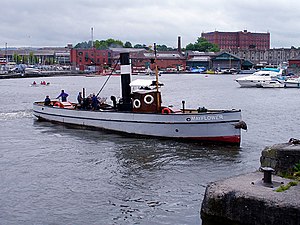Mayflower (tugboat)
 |
|
| History | |
|---|---|
| England | |
| Name: | Mayflower |
| Builder: | G.K. Stothert & Marten |
| Cost: | £1000 |
| Launched: | 18 May 1861 |
| Christened: | Mayflower |
| In service: | 1861 |
| Out of service: | 1964 |
| Homeport: | Gloucester |
| Status: | Museum ship in Bristol Harbour |
| General characteristics | |
| Tonnage: |
|
| Length: | 65 ft (20 m) |
| Beam: | 12 ft (3.7 m) |
| Draught: | 7 ft (2.1 m) |
Mayflower is a steam tug (tugboat) built in Bristol in 1861 and now preserved by Bristol Museums Galleries & Archives. She is based in Bristol Harbour at M Shed (formerly Bristol Industrial Museum). She is the oldest Bristol-built ship afloat and is believed to be the oldest surviving tug in the world.
She was built by GK Stothert & Co, who were connected with the Bath-based engineering company Stothert & Pitt. A branch of the family came to Bristol to build railway locomotives (later to become the Avonside Engine Company). After 1852, a separate shipbuilding company was established which survived in business until the 1930s.
Mayflower was built to work on the Gloucester and Sharpness Canal and in the River Severn, one of three tugs ordered after trials had shown how much more efficient than horses they were. Altogether they cost £3000.
Mayflower started working between Sharpness and Gloucester Docks, towing trains of small sailing vessels such as trows and ketches, and, after the new docks at Sharpness were completed in 1874, larger steamers one at a time. By the late 1890s she was the most seaworthy tug in the fleet, and she was altered to make her suitable for work in the Bristol Channel. The old single-cylinder engine was replaced in 1899 with a vertical compound condensing engine supplied, along with a new boiler, funnel, propeller and shafting by W.Sisson & Co. of Gloucester for £940. The steering position, which had previously been behind the funnel, was moved forward, and a waist high iron steering shelter added to give the skipper some comfort. She went back to work outside Sharpness, towing sailing vessels through the dangerous stretches of the Severn Estuary to the mouth of the river Wye and back again.
...
Wikipedia
